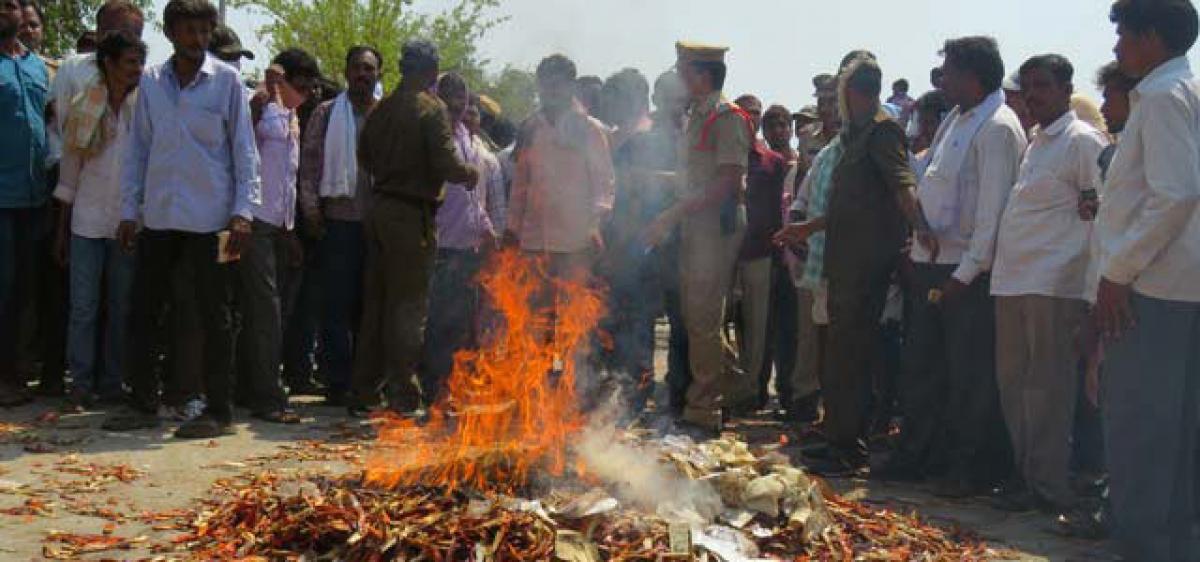Live
- Will gift one project daily to people during Jan Kalyan Parv
- Mahakumbh & the Politics of Sanatan Nationalism
- A Soulful Celebration of Global Music
- Brahmin Community delegation felicitates CM Saini
- Allu Arjun Visits Chiranjeevi’s House for Lunch Meet
- Toyota organising TG Grameena Mahotsav
- Special rituals conducted at Maramma Temple
- Siddaramaiah has special love for Muslims: BJP
- We can’t afford spending less than 6% of GDP on healthcare
- Guinness World Record for continuous Hanuman Chalisa chanting
Just In
Failure to consider produce forecast impacted farmers’ prospects


Concerned and conscious citizens of Hyderabad are grossly unimpressed over lack of people-centric and nature-centric policy making that has caused contrast situations, wherein the capital city is pampered while the farmer is trampled.
Concerned and conscious citizens of Hyderabad are grossly unimpressed over lack of people-centric and nature-centric policy making that has caused contrast situations, wherein the capital city is pampered while the farmer is trampled. Government is oblivious of its fundamental duty to use marketing intelligence data, and, of preparedness to establish systemic changes to empower farmers.
Chilly farmers from hinterlands spice up the menus of hitech city, but in turn are left to crave for basic returns on their harvest; nowhere the focus and priority of state and central governments. State government, Central government and opposition parties have all unforgivably ignored the Chilly price and produce forecast, of Marketing Intelligence Department of Telangana State Agricultural University, Hyderabad, much to the detriment of cultivators and the economy.
Central government's Market Intervention Prices of Rs.5000 per quintal or State Government's proposal of Rs.7000 per quintal are not in tandem with the econometrics of the Telangana State Agricultural University.
Market Intelligence Forecast
According to Network Project on Market Intelligence's (NPMI) Rabi pre-harvesting forecast for 2016-17, 'chilli price per quintal will be around Rs 11000-11400 at the time of harvesting (February to March 2017)'. Price forecast for Chillies was done at NPMI, Dept. Of Agricultural Economics, Prof.Jayashankar Telangana State Agricultural University, (PJTSAU), Rajendranagar, Hyderabad 'based on the econometric analysis done on the price of chillies that prevail in the Guntur regulated market.
NPMI's econometric price analysis is done 'keeping in view deficit in rainfall, cropped area, stock position, for the benefit of farmers to take suitable decisions'. Forecasted Chilli price per quintal at the time of harvesting (February-April 2017) was around Rs 10200-10600 . Likewise, Kharif pre-harvesting price forecast was around Rs 9800 - 10400 at the time of harvesting (October to December 2016)'.
Thus, price forecast has never been below Rs.10000 per quintal for dry chillies. Above review of the forecasts announced by NPMI puts the state government, central government and all political parties in a spot for not favouring the chilli farmers with their rightly due prices, but announcing prices that would fetch goodwill of farmers and give electoral edge.
Similarly, NPMI forecast for (February to April 2016) at harvest was Rs 8,600-8,900 per quintal, and, Rs. 10,500-10700 for May 2016. Likewise, in 2015, forecasted price at harvest was Rs.7500-9500/quintal, and Rs. 8600 -9600 per quintal at harvest for December 2014. Market prices of 2016, 2015 and 2014 were close to the price forecasts of NPMI, as cited above.
Why then didn't econometrics of NPMI match the market prices of dry chillies in the months of April-May 2017 is for the state governments at State, Central government and opposition parties to answer. A similar situation arose when Red gram prices had touched 12,000-14,000 per quintal during 2015-16.
Farmers were urged by the government to shift from cotton to red gram during Kharif 2016. Expectations soared high but prices slumped when home produce clashed in the markets with imported red gram from Africa.
Diversification of Risk
While Rs.4000 per acre for fertilizer was portrayed as government's pro-agriculture measure, this would only encourage continuation with chemical farming which has been the root cause of farmers being driven to suicides.
Mini and micro familial undertakings at farming sites for production and export of products of dry chillies, intra- and inter-country, could have been a game changer for the beleaguered agriculture enterprise. Consultative participative culture, that generates unity of knowledge with inputs of institutions, indigenous as well as other interacting factors, was denied to the chilli farmers in particular, and to farmer fraternity in general.
Thus on that fateful day of 28th April 2017, farmers chose to ash their sweat, and burnt their crops, while the grandiose celebrations of the ruling party’s anniversary was being held in Warangal. There is conspicuous disregard for a sector that is still the largest employment provider in the country, a sector that pollutes the least and nourishes the society.
Successive governments have met their waterloo by sidelining agriculture and increasingly usurping farmers rights, even as they 'extra dose' cities with pollution of air, water and soil. (Dr Lubna Sarwath is founder, Center for Wellbeing Economics and Saraswati Kavula is a farmer and activist)
By Dr Lubna Sarwath & Saraswati Kavula

© 2024 Hyderabad Media House Limited/The Hans India. All rights reserved. Powered by hocalwire.com






